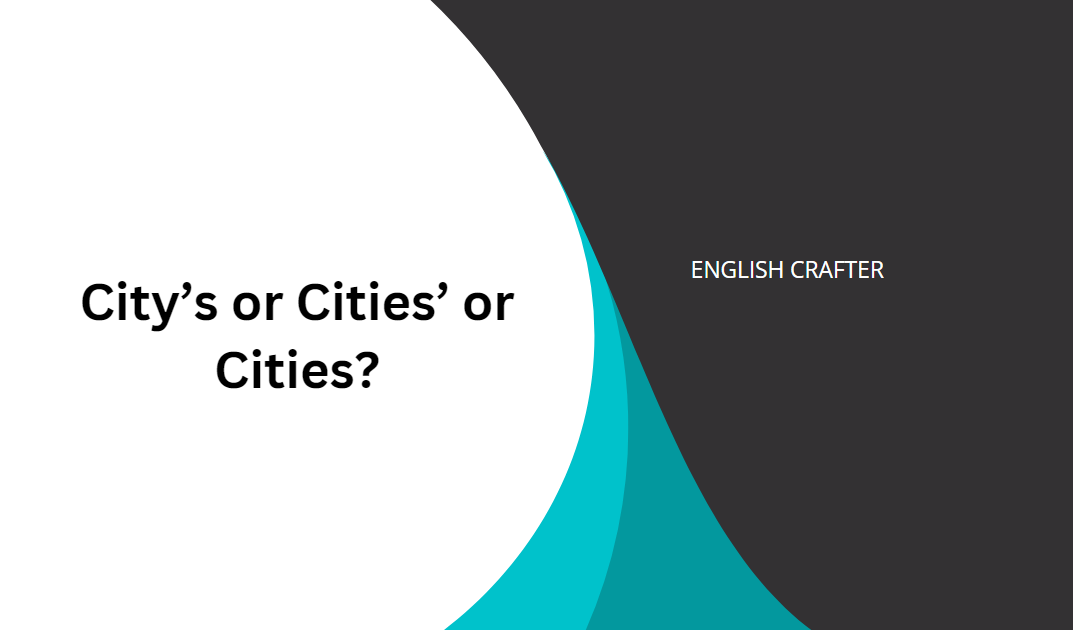City’s or Cities’ or Cities?


The word city’s is the singular possessive version of city. For example, “The city’s infrastructure has undergone significant improvements.” Conversely, cities’ is the plural possessive, as in, “The cities’ residents celebrated the cultural diversity.” Additionally, the word cities is the standard plural form of city.
The chart below outlines the different versions of the word city, with the plural formed by adding “-ies” due to the ending “y.”
| Form | Example |
| Singular | City |
| Plural | Cities |
| Singular Possessive | City’s |
| Plural Possessive | Cities’ |
Here are examples of the four forms in context:
- Singular: Living in a bustling city offers numerous opportunities.
- Plural: The cities in this region showcase unique architectural styles.
- Singular possessive: The city’s public transportation system is efficient.
- Plural possessive: The cities’ economic strengths differ based on various factors.
Perhaps you still have doubts about the possessive forms of City. If so, please keep reading the rest of the article, where we explain more about the possessive and plural forms of the term City.
City’s
The term city’s is the singular possessive form of city, indicating things that a single city possesses.
The singular possessive is often used to describe specific aspects of a city or its characteristics. Examples include:
- The city’s skyline is dominated by modern skyscrapers.
- Our city’s parks are well-maintained and popular among residents.
- The city’s rich history is evident in its historical landmarks.
Moreover, the singular possessive can extend to non-physical aspects of a city, such as its culture and spirit.
- The city’s culture embraces diversity and inclusivity.
- The city’s spirit is resilient, even in challenging times.
- The city’s reputation for innovation attracts entrepreneurs.
In addition, the phrase city’s charm can be used to emphasize a particular appealing quality within a single city.
- The historic architecture adds to the city’s charm.
- The vibrant street art contributes to the city’s charm.
Cities’
Cities’ is the plural possessive version of city, indicating that multiple cities possess or own something.
Cities do possess tangible items in the same way individuals might. Therefore the use of the plural possessive for cities may therefore similar;
- The cities’ roads and bridges make travel smoother for everyone.
- During the health crisis, cities’ hospitals faced many challenges.
- Cities’ buses and trains help people get around more easily.
The plural possessive of city is commonly used when referring to shared characteristics among cities or attributes collectively owned by multiple cities.
- The cities’ collaboration resulted in a successful cultural exchange.
- Our state promotes tourism through the cities’ unique offerings.
- The cities’ educational systems vary in curriculum and approach.
Moreover, it is used to describe infrastructure or facilities designed to benefit multiple cities.
- The transportation network enhances the cities’ connectivity.
- The cities’ joint efforts led to improved environmental sustainability.
- The region invests in the cities’ healthcare facilities.
Furthermore, the term city’s development can also appear in plural form if referring to growth and progress shared by more than one city.
- The cities’ development plans prioritize sustainable practices.
- Our neighboring cities’ development projects align with regional goals.
Cities
Cities is the plural version of city, suitable for use in non-possessive sentences when referring to more than one city.
This plural form can be used in two ways:
- To indicate a specific number of cities:
- There are five cities in the metropolitan area.
- The conference attracted representatives from ten cities.
- To refer to cities collectively:
- Cities play a crucial role in shaping regional economies.
- Many cities experience a surge in population during the summer.






